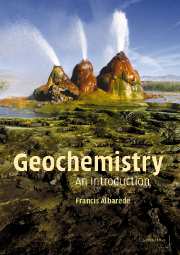Book contents
- Frontmatter
- Contents
- Foreword to the English edition
- Foreword to the French edition
- Acknowledgments
- Introduction
- 1 The properties of elements
- 2 Mass conservation – elemental and isotopic fractionation
- 3 Geochronology and radiogenic tracers
- 4 Element transport
- 5 Geochemical systems
- 6 Waters present and past
- 7 Mineral reactions
- 8 The solid Earth
- 9 The Earth in the Solar System
- 10 The geochemical behavior of selected elements
- Appendix A Composition of the major geological units
- Appendix B The mixing equation for ratios
- Appendix C A refresher on thermodynamics
- Appendix D The Rayleigh distillation equation
- Appendix E The geological time scale
- Appendix F An overview of analytical methods
- Appendix G Physical and geophysical constants
- Appendix H Some equations relative to residence time
- Further reading
- Index
5 - Geochemical systems
- Frontmatter
- Contents
- Foreword to the English edition
- Foreword to the French edition
- Acknowledgments
- Introduction
- 1 The properties of elements
- 2 Mass conservation – elemental and isotopic fractionation
- 3 Geochronology and radiogenic tracers
- 4 Element transport
- 5 Geochemical systems
- 6 Waters present and past
- 7 Mineral reactions
- 8 The solid Earth
- 9 The Earth in the Solar System
- 10 The geochemical behavior of selected elements
- Appendix A Composition of the major geological units
- Appendix B The mixing equation for ratios
- Appendix C A refresher on thermodynamics
- Appendix D The Rayleigh distillation equation
- Appendix E The geological time scale
- Appendix F An overview of analytical methods
- Appendix G Physical and geophysical constants
- Appendix H Some equations relative to residence time
- Further reading
- Index
Summary
This chapter looks at the changes that over time affect the geochemical properties of a system or a set of systems, such as the mantle, the crust, or the ocean, when subjected to disturbances whether caused naturally or by human activity. The essential concepts utilized – residence time and forcing – are taken from chemical engineering. Viewing system Earth as a chemical factory composed of reactors, valves, sources, and sinks, has proved to be a simple and robust model. The theory goes by various names, with the “box model” probably the most widely used. We will first set out the principles by describing the behavior of a system with a single reservoir and then go on to generalize the approach.
Single reservoir dynamics
Let us begin by considering a lake (Fig. 5.1) containing a mass of water M that we will take to be constant. A river flows through the lake with a rate of flow Q, which we will express in kilograms per year. Q is therefore the same upstream and downstream. We are interested in the balance of a chemical species in the lake. A chemical element introduced upstream may be carried away downstream or be taken up by sedimentation, at a rate P also expressed in kilograms per year. The lake itself is considered homogeneous, being well mixed by turbulent flow and by convection.
The concentration Ci of an element i is therefore the same in the lake and in the downstream outflux.
- Type
- Chapter
- Information
- GeochemistryAn Introduction, pp. 81 - 94Publisher: Cambridge University PressPrint publication year: 2003

